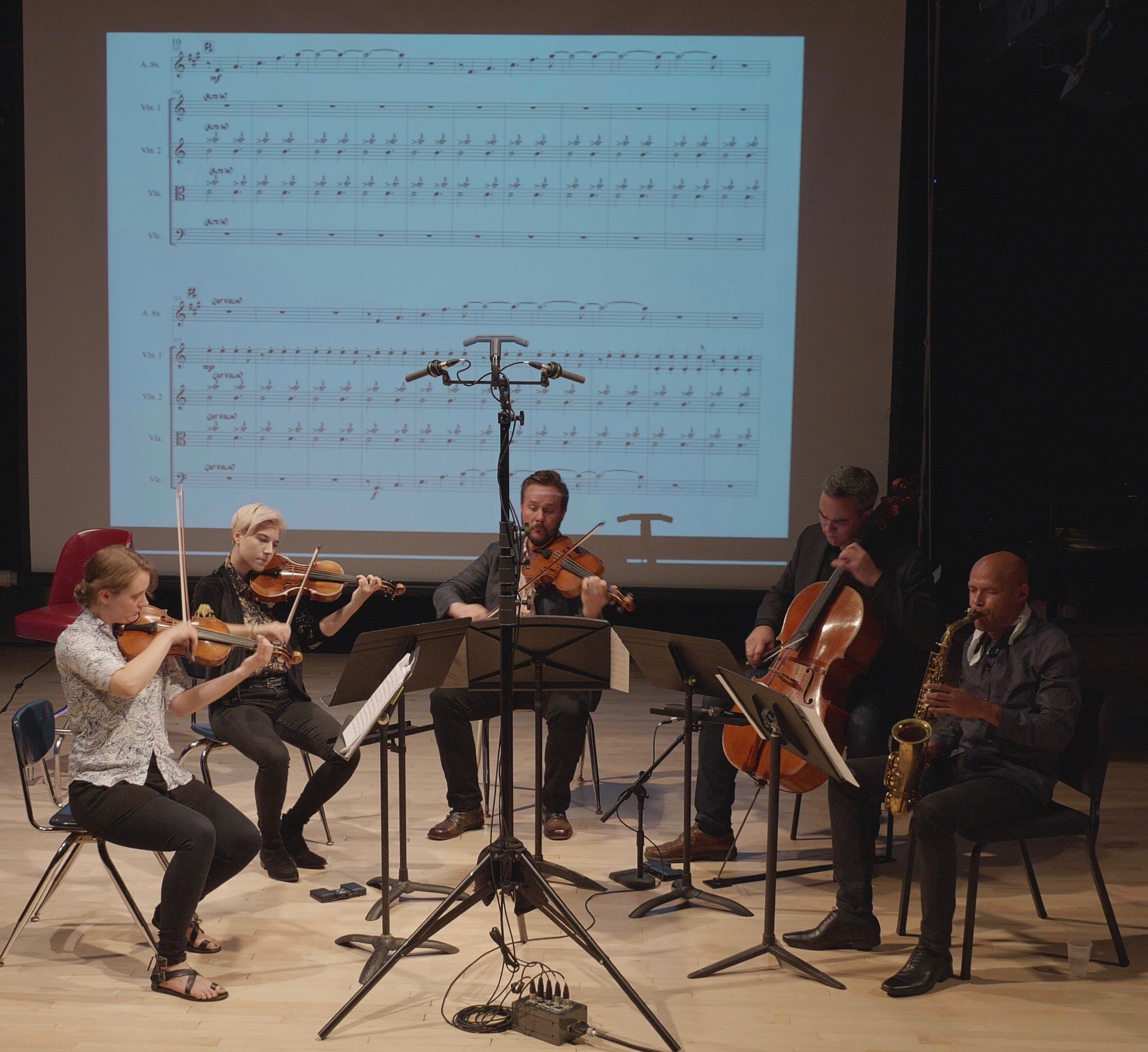Spektral Quartet gives a tasting of new album with saxophonist Miguel Zenón

Spektral Quartet’s new album is out– an eight-movement suite titled Yo Soy La Tradición, composed by saxophonist Miguel Zenón, who performs it with the quartet.
The Spektral musicians (violinists Clara Lyon and Maeve Feinberg, violist Doyle Armbrust and cellist Russell Rolen) and Zenón will be taking the suite on the road, touring the country. But on Thursday night, the eve of the album’s release, they gave an unusual concert at Constellation: an in-depth look at the penultimate movement of the suite, titled “Promesa.”
The special format was part of Spektral Quartet’s “Once More, With Feeling!” project. It is based on a simple premise: relationships with a piece strengthen upon repeated listening, but audiences of contemporary music often get to hear a new piece only once. So, why not play the piece twice in an evening, with some discussion and analysis with the composer in between, to deepen the audience’s understanding?
Zenón’s music is particularly well-suited to this approach because one can deconstruct not only the music’s structure but also the different cultural influences that are combined within it. The basic form and style of the suite is classical. But the melodies are inspired by folk music from the Puerto Rican composer’s homeland, and the music occasionally bursts forth into extended jazz solos for Zenón.
On the first pass through “Promesa,” the opening cello solo is striking, punctuated by occasional shimmering chords from the other strings. The asymmetrical groove is played with typical taut precision by Spektral. A smooth arpeggio-based melody for Zenón’s saxophone, glides over the ever-changing groove. And, at the movement’s center is a virtuosic solo by Zenón: very notey and yet still melodic, filled with rhythmic accents but not percussive.
During the discussion portion, Zenón described the premise of the piece, and the experience of recording it during the height of Hurricane Maria. This included explaining what a promesa is: A promise to a saint or religious figure, a sacrifice from the supplicant in exchange for a favor from the saint. These are often commemorated at a party with music. It was at one such party that Zenón heard the tune that was the basis for the movement’s main melody.
The original tune was an unusual seven bars in length. This inspired Zenón to structure the movement around various mathematical manipulations of the number seven. In the conversation that followed, excerpts from the score were projected on the screen while Zenón talked through them, and he and the quartet demonstrated specific passages. There was no feeling of “dumbing down” for the audience, with the explanations unflinchingly technical.
An example: When the main melody is introduced, there are three out-of-sync layers going on. The music is in 7/4 time. The viola and cello are playing chords that each last seven sixteenths, and the two violins are playing octave E’s that each last a quarter-note beat (which is four sixteenths). Their cycles therefore align once a bar. (One bar = 28 sixteenths = 4 x 7 sixteenths [viola/cello] = 7 x 4 sixteenths [violins].) The saxophone meanwhile is playing four-beat phrases. It therefore aligns with the strings every four bars. This is the same relationship as before, except multiplied by four. (Four bars = 28 quarters = 4 x 7 quarters [strings] = 7 x 4 quarters [saxophone]).
You can well tell if you would have liked the analysis portion of the evening based on whether you could follow that explanation, and whether you found it worth following.
Even without sweating the technical details, hearing the movement again after the discussion made a big difference. Zenón revealed that the cello solo at the opening was improvised, and the other strings could bring in their chords when they wished. You could now perceive the musicians watching each other, deciding how to coordinate their entrances. Whether or not you understood how the cycles worked, you could feel them weaving in and out of alignment.
And then there was great difference in the two versions of Zenón’s solos: Despite its virtuosity, the first one had a certain suavity. But his second one was pure passion, cascades of notes swelling with emotion.
As a bonus, they played one more movement from the suite: the opening, titled “Rosario.” The explanation of “Promesa” indirectly provided a window into “Rosario” as one could draw parallels between the two movements: the tentative openings, the slow of a melody and a groove, the centrally placed virtuosic solo, the fragmenting of the melody after the solo is done.
The lingering question here has to be: Is such a forthrightly pedagogical approach fruitful? Do we really want (or need) to have music broken down for us like this in a concert hall? Classical music has asked these questions before.
In the year that marks Leonard Bernstein’s centenary year, it’s worth noting that Bernstein’s contribution to American musical life lay not only in his composing and conducting, but also in his Herculean efforts to bring musical understanding to the public. If such efforts were worthwhile then, they are even more worthwhile now, as classical music increasingly struggles for an audience.
If Thursday night’s concert at Constellation was any indication, the Spektral Quartet’s commitment, enthusiasm, and skill at executing such a project make them the right people for the job.
Miguel Zenón and the Spektral Quartet will perform the complete Yo Soy La Tradición suite, 7 p.m. Friday at the Segundo Ruiz Belvis Cultural Center, 4046 W. Armitage. The proceeds will go to supporting artists affected by Hurricanes Maria and Irma. http://spektralquartet.com/concerts/2018/9/21/yo-soy-la-tradicin-a-benefit-for-puerto-rico
Posted in Performances




